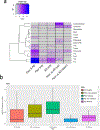Atopic Dermatitis Is an IL-13-Dominant Disease with Greater Molecular Heterogeneity Compared to Psoriasis
- PMID: 30641038
- PMCID: PMC6711380
- DOI: 10.1016/j.jid.2018.12.018
Atopic Dermatitis Is an IL-13-Dominant Disease with Greater Molecular Heterogeneity Compared to Psoriasis
Abstract
Atopic dermatitis (AD) affects up to 20% of children and adults worldwide. To gain a deeper understanding of the pathophysiology of AD, we conducted a large-scale transcriptomic study of AD with deeply sequenced RNA-sequencing samples using long (126-bp) paired-end reads. In addition to the comparisons against previous transcriptomic studies, we conducted in-depth analysis to obtain a high-resolution view of the global architecture of the AD transcriptome and contrasted it with that of psoriasis from the same cohort. By using 147 RNA samples in total, we found striking correlation between dysregulated genes in lesional psoriasis and lesional AD skin with 81% of AD dysregulated genes being shared with psoriasis. However, we described disease-specific molecular and cellular features, with AD skin showing dominance of IL-13 pathways, but with near undetectable IL-4 expression. We also demonstrated greater disease heterogeneity and larger proportion of dysregulated long noncoding RNAs in AD, and illustrated the translational impact, including skin-type classification and drug-target prediction. This study is by far the largest study comparing the AD and psoriasis transcriptomes using RNA sequencing and demonstrating the shared inflammatory components, as well as specific discordant cytokine signatures of these two skin diseases.
Copyright © 2019 The Authors. Published by Elsevier Inc. All rights reserved.
Figures






References
-
- Andrews S FastQC: a quality control tool for high throughput sequence data., http://www.bioinformatics.babraham.ac.uk/projects/fastqc; 2010. [accessed.
-
- Bissonnette R, Papp KA, Poulin Y, Gooderham M, Raman M, Mallbris L, et al. Topical to facitinib for atopic dermatitis: a phase IIa randomized trial. Br J Dermatol 2016;175(5):902–11. - PubMed
-
- Blauvelt A, de Bruin-Weller M, Gooderham M, Cather JC, Weisman J, Pariser D, et al. Long-term management of moderate-to-severe atopic dermatitis with dupilumab and concomitant topical corticosteroids (LIBERTY AD CHRONOS): a 1-year, randomised, double-blinded, placebocontrolled, phase 3 trial. Lancet 2017;389(10086):2287–303. - PubMed
Publication types
MeSH terms
Substances
Grants and funding
LinkOut - more resources
Full Text Sources
Other Literature Sources
Medical
Molecular Biology Databases

